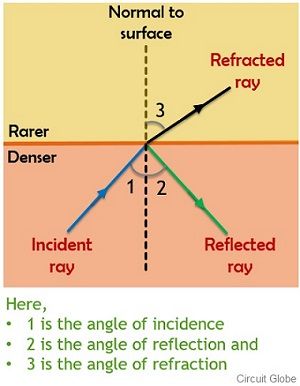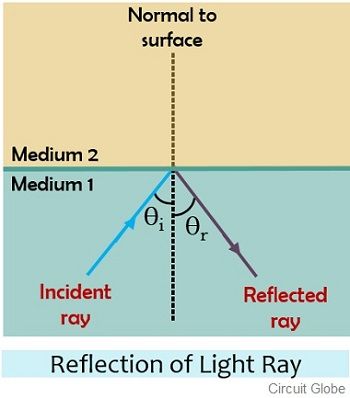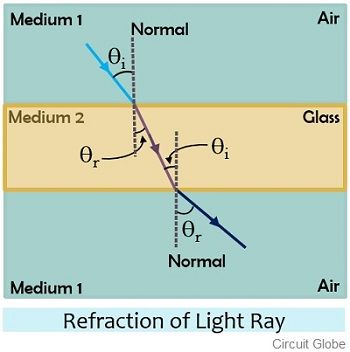Reflection and Refraction are the two major phenomena related to the propagation of beam of light. The crucial difference between reflection and refraction is that reflection is the act of the rebounding of the light wave in the same medium after striking the boundary of a different medium. As against refraction is the phenomenon of bending of light rays towards a different medium after interacting with the boundary of that medium.
Reflection and refraction are the two most basic characteristics of a light wave.
We know that electromagnetic radiation ranging from 400 to 750 nm is called light. As the human eye is sensitive to this specific range of wavelength and thus is able to detect it. Light and our sense of vision are the two main factors that allow the interpretation of objects around us. As light permits us to see the object around us because in darkness nothing is visible at all.
We know that light travels with great speed and that too in a straight line. This straight path followed by light is termed as a ray of light and multiple rays forming bundle is known as a beam of light. Thus reflection and refraction are the two major concepts that must be considered while dealing with light and in this article, we will discuss the difference between these two concepts in detail.
Content: Reflection Vs Refraction
Comparison Chart
| Basis for Comparison | Reflection | Refraction |
|---|---|---|
| Basic | It is the rebounding phenomena of light ray in the same medium. | It is the bending of light ray towards a different medium. |
| Type of Surface | Shinny surfaces. | Transparent surfaces. |
| Medium of Propagation | Remains same | Gets changed. |
| Propagation speed of ray | No change. | The propagation speed shows variation according to material medium. |
| Law associated | The angle of incidence and reflection is equal. | The ratio of sine of incidence angle to sine of refraction angle is a constant term. |
Definition of Reflection
Reflection is defined as the change in direction of light rays due to bouncing back towards the same medium after striking the boundary of a different medium. The figure below shows the reflection of a light ray:
We have already discussed that our sense of vision and light both are needed to see any object present near our surroundings. Basically when a source emits light and the emitted ray strikes an object present in the surrounding then it gets reflected towards the eyes of the human being and the sense of vision allows the human to see that object.
Majorly there are 3 different conditions due to which light ray alters its direction:
- While getting reflected from a surface,
- Moving from a transparent medium to the other one or
- Propagating in such a medium that has continuously changing composition.
When a light ray, propagates and encounters a medium that has a different refractive index than the refractive index of actually propagating medium then there is variation in direction of propagation of ray. And this change of direction results in a reflection of light rays towards the same medium.
There are two basic laws of reflection that states:
- The angle of incidence and angle of reflection are equal and
- Reflected ray and incident ray lie in a similar plane along with the normal.
Reflection of light is generally classified in two ways on the basis of the surface from which it gets reflected.
- Specular reflection: The reflection resulting from a smooth body like a mirror is called specular reflection.
- Diffuse reflection: When the surface on which light is incidenting is a rough one like paper or cloth then it is known as diffuse reflection.
Definition of Refraction
Refraction is defined as the bending of light rays because of experiencing a difference in the refractive index of the medium. More simply, we can say, when light rays strike the boundary of a medium that has a different refractive index then, the ray changes its direction, bends, and starts propagating in the medium of different refractive index.
Basically when the medium of propagation is changed, then the ray propagates with a different speed from the earlier one. This change in the speed leads to cause variation in the direction of propagation. The figure below represents the refraction of light ray:
As we can see in the above figure that initially the light ray is propagating from air to glass (i.e., from rarer medium to denser medium). In such a case, the light ray shows bending towards the normal. While when the ray is propagating from denser medium to rarer medium (i.e., from glass to air), then the ray bends away from the normal.
In an optically rarer medium, the speed of light increases, therefore due to an increase in speed, the ray gets bent in a direction away from the normal. While in an optically denser medium, the speed of ray decreases, thus due to a decrease in speed, the light ray gets bents towards the normal. Thus we can say refraction depends on a material medium where light is incidenting.
Key Differences Between Reflection and Refraction
- The phenomenon of bouncing back of light rays, to that particular medium itself on experiencing a different medium is known as reflection. As against the bending of the light ray to a different medium on striking the boundary of a different surface is termed as refraction.

- Reflection generally occurs in shinny surfaces that allow rebounding of light without permitting penetration through it. While refraction occurs in transparent surfaces that allows bending of the ray to a different medium.
- In the case of reflection, the medium in which light propagates remains the same. Whereas in refraction, the medium of propagation gets changed.
- When a light ray strikes the boundary of a different medium then in the case of reflection the speed of the light ray does not vary. While in the case of refraction, the speed varies with the medium in which the ray undergoes bending.
- The law of reflection states that the incident angle and reflection angle are equal to each other. While the law of refraction states that the ratio of the sine of an incident angle to the sine of the refraction angle is a constant value.
- Reflection generally takes place in mirrors. Whereas refraction takes place in lenses in general conditions.
Conclusion
The phenomenon of reflection and refraction from the above discussion can be inferred in a way that reflection permits the ray to propagate in the same medium even after striking the surface. While refraction contradicts this behavior of light and the ray propagates in a different medium.


